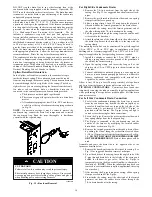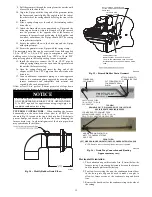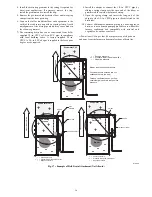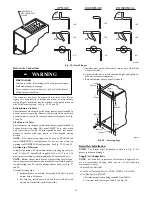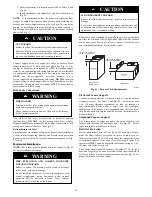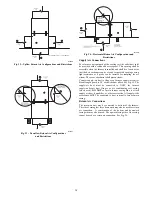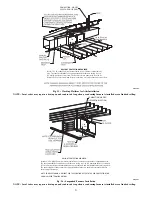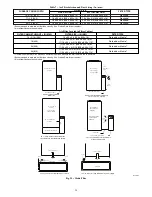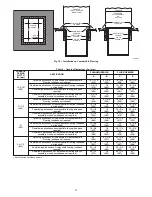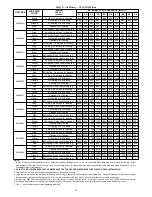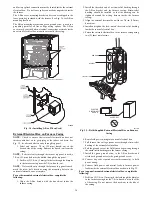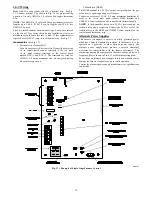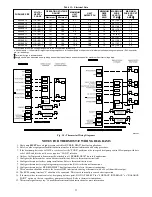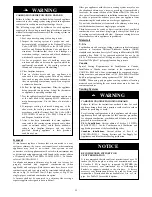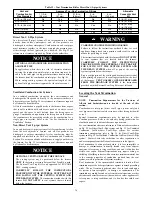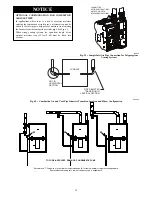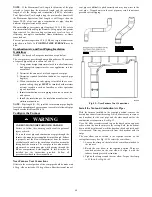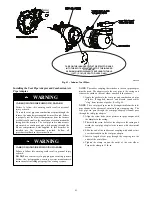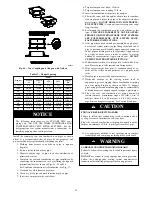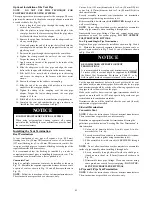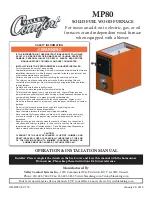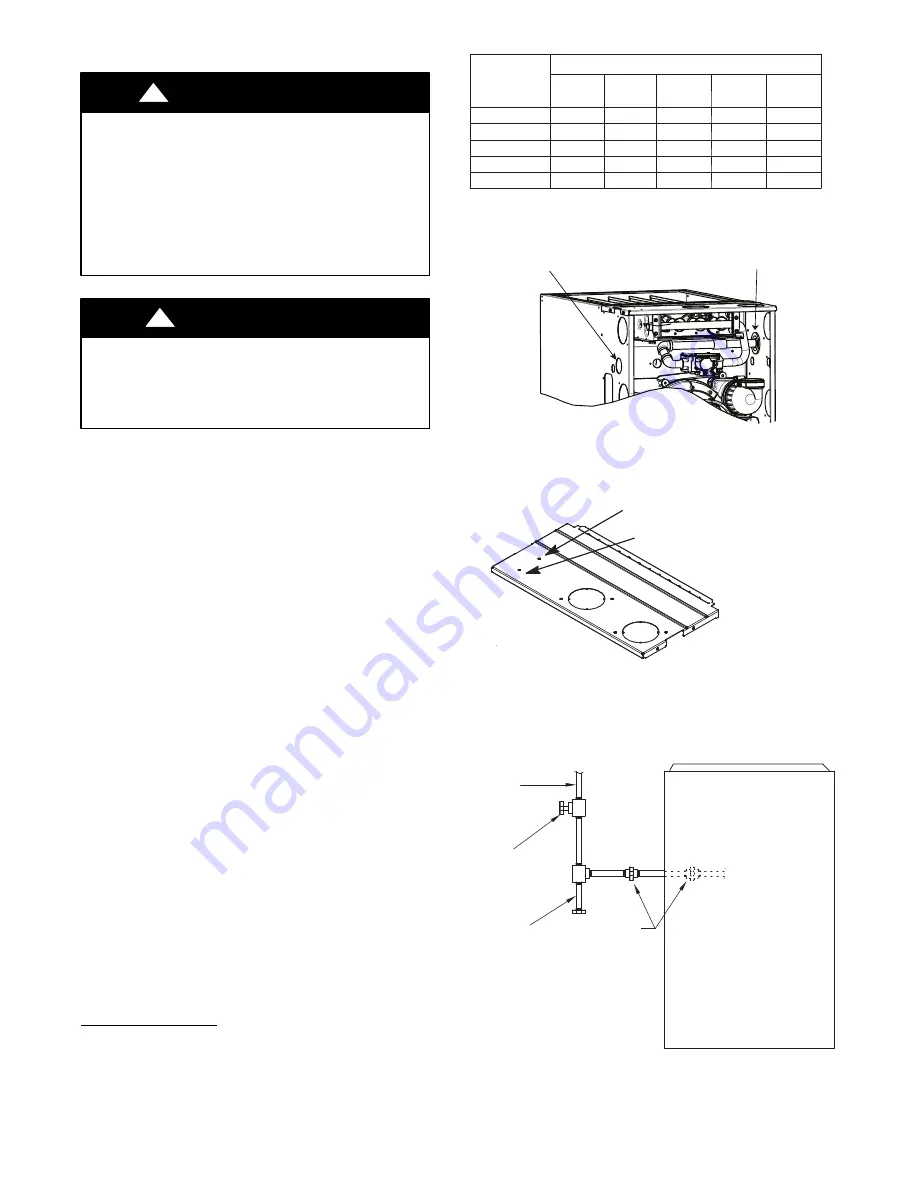
28
sparingly and only to male threads of joints. Pipe dope must be
resistant to the action of propane gas.
FIRE OR EXPLOSION HAZARD
A failure to follow this warning could result in personal
injury, death, and/or property damage.
If local codes allow the use of a flexible gas appliance
connector, always use a new listed connector. Do not use a
connector which has previously served another gas
appliance. Black iron pipe shall be installed at the furnace
gas control valve and extend a minimum of 2--in. (51 mm)
outside the furnace.
!
WARNING
FURNACE DAMAGE HAZARD
Failure to follow this caution may result in furnace damage.
Connect gas pipe to furnace using a backup wrench to
avoid damaging gas controls and burner misalignment.
CAUTION
!
An accessible manual equipment shutoff valve MUST be installed
external to furnace casing and within 6 ft. (2 M) of furnace.
Install a sediment trap externally in the riser leading to furnace as
shown in Fig. 33. Connect a capped nipple into lower end of tee.
Capped nipple should extend below level of furnace gas controls.
Place a ground joint union between furnace gas control valve and
exterior manual equipment gas shutoff valve.
A 1/8--in. (3 mm) NPT plugged tapping, accessible for test gauge
connection, MUST be installed immediately upstream of gas
supply connection to furnace and downstream of manual
equipment shutoff valve.
Piping should be pressure and leak tested in accordance with the
current edition of the NFGC in the United States, local, and
national plumbing and gas codes before the furnace has been
connected. Refer to current edition of NSCNGPIC in Canada.
After all connections have been made, purge lines and check for
leakage at furnace prior to operating furnace.
NOTE
:
The furnace gas control valve inlet pressure tap
connection is suitable to use as test gauge connection providing
test pressure DOES NOT exceed maximum 0.5 psig (14--in. w.c.)
stated on gas control valve. See Fig. 60.
If pressure exceeds 0.5 psig (14--in. w.c.), gas supply pipe must be
disconnected from furnace and capped before and during supply
pipe pressure test. If test pressure is equal to or less than 0.5 psig
(14--in. w.c.), turn off electric shutoff switch located on furnace gas
control valve and accessible manual equipment shutoff valve
before and during supply pipe pressure test. After all connections
have been made, purge lines and check for leakage at furnace prior
to operating furnace.
The gas supply pressure shall be within the maximum and
minimum inlet supply pressures marked on the rating plate with
the furnace burners ON and OFF.
Gas entry can be from left or right side, or top panel. See Fig. 31
and 32.
Gas Pipe Grommet
For direct vent (2-pipe) applications, the knockout for the gas pipe
must be sealed to prevent air leakage. Remove the knockout, install
the grommet in the knockout, then insert the gas pipe. The
grommet is included in the loose parts bag. See Fig. 31.
Table 10 – Maximum Capacity of Pipe
NOMINAL
IRON PIPE
SIZE
IN. (MM)
LENGTH OF PIPE --- FT (M)
10
(3.0)
20
(6.0)
30
(9.1)
40
(12.1)
50
(15.2)
1/2 (13)
175
120
97
82
73
3/4 (19)
360
250
200
170
151
1 ( 25)
680
465
375
320
285
1-1/4 (32)
1400
950
770
660
580
1-1/2 (39)
2100
1460
1180
990
900
* Cubic ft of gas per hr for gas pressures of 0.5 psig (14---in. w.c.) or less
and a pressure drop of 0.5---in. w.c. (based on a 0.60 specific gravity gas).
Ref: Table 10 above and 6.2 of NFPA54/ANSI Z223.1 (current edition).
Gas Pipe Grommet Required
For Direct Vent Applications
Left Side Gas Entry. Gas Pipe
Grommet Required For Direct
Vent Applications.
A11338
Fig. 31 -- Gas Entry
1
ï
1/2 inch for Gas
7/8 inch for 115 VAC Electric
A170125
Fig. 32 -- Alternate Gas and Electric Entry
NOTE: Top plate may be field drilled for alternate gas and
115 VAC electric entry.
GAS
SUPPLY
MANUAL
SHUT OFF
VALVE
(REQUIRED)
SEDIMENT
TRAP
UNION
NOTE: Union may be inside the
vestibule where permitted by
local codes.
FRONT
A11035
Fig. 33 -- Typical Gas Pipe Arrangement

